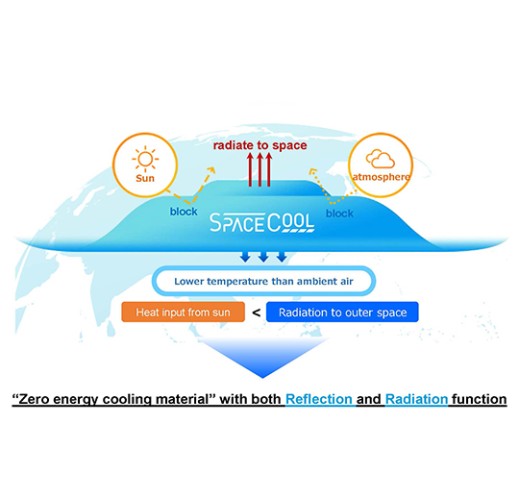Radiative Cooling Material "SPACECOOL"

SPACECOOL INC.
SPACECOOL INC.
Technology / Service Summary
SPACECOOL is an innovative material that blocks heat from sunlight and emits it into outer space through the principle of radiative cooling, enabling zero-energy temperature reduction below the ambient air temperature.
By applying this material to facilities exposed to direct sunlight—such as buildings or outdoor electrical equipment—it is possible to suppress temperature rise without generating CO₂ emissions, thereby reducing air-conditioning energy consumption. In addition to contributing to carbon neutrality, this technology also holds potential for preventing heatstroke and improving labor productivity.
Purpose
By applying SPACECOOL to buildings and social infrastructure, we can suppress temperature increases and reduce air conditioning energy consumption, contributing to the realization of a carbon-neutral society.
Feature
A leading radiative cooling material that can cool below the outside temperature with zero energy even under direct sunlight by radiating heat into space. This ultra-thin optical sheet, less than 0.1 mm thick, features a unique multilayer structure designed to block heat from sunlight and the atmosphere with a thermal insulation capability (reflectivity of over 95%) while also providing a radiative cooling function (emissivity of over 95%) that converts thermal energy into light energy in the atmospheric window wavelength range.
Effect
1.Demonstration Test of Distribution Boards
Distribution boards are equipped with electronic devices inside, and there are many cases where the increase in internal temperature due to direct sunlight leads to degradation or failure of the equipment. Traditionally, thermal countermeasures have been implemented using heat-insulating paints or shading panels, but no significant effects were observed. However, when SPACECOOL was applied to the surface of the distribution board, an internal temperature decrease of approximately 8°C was confirmed compared to conventional methods.
2.Case Study of Air Conditioning Outdoor Units
Air conditioning outdoor units are at risk of increased power load and operational shutdown due to temperature rise caused by direct sunlight. It has been reported by installation sites that the surface temperature of the outdoor units decreased by about 7°C when SPACECOOL was applied, resulting in an 18% reduction in energy consumption.
3.Case Study of Rooftop Installation on Buildings
A waterproof sheet utilizing SPACECOOL was applied to approximately 600 square meters of the rooftop of a facility owned by the Tokyo Metropolitan Bureau of Transportation. The effectiveness of reducing air conditioning energy consumption inside the building during the summer is being verified.
Controlled Substance
Reference
Applicable Regions / Countries
- Japan
- Southeast Asia
- Central/South Asia
- China/ East Asia
- Middle East
- Africa
- Oceania
- Europe
- Central/South America
- ASEAN countries
Indonesia,Cambodia,Singapore,Thailand,Philippines,Brunei Darussalam,Viet Nam,Malaysia,Myanmar,Lao PDR
Reference URL
Related SDGs Goals
- 3. Good Health and Well-being
- 7. Affordable and Clean Energy
- 9. Industry, Innovation and Infrastructure
- 13. Climate Action


